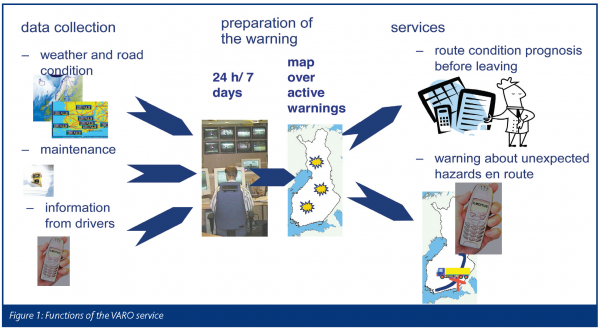Towards real-time ITS services
- Like
- Digg
- Del
- Tumblr
- VKontakte
- Buffer
- Love This
- Odnoklassniki
- Meneame
- Blogger
- Amazon
- Yahoo Mail
- Gmail
- AOL
- Newsvine
- HackerNews
- Evernote
- MySpace
- Mail.ru
- Viadeo
- Line
- Comments
- Yummly
- SMS
- Viber
- Telegram
- Subscribe
- Skype
- Facebook Messenger
- Kakao
- LiveJournal
- Yammer
- Edgar
- Fintel
- Mix
- Instapaper
- Copy Link
Posted: 24 June 2005 | Seppo Öörni, Head of ITS Group, Ministry of Transport & Communications Finland | No comments yet
Finland is focussing its ITS related R&D activities up to 2007 on real-time traffic and transport information in the form of a three year AINO programme.
Finland is focussing its ITS related R&D activities up to 2007 on real-time traffic and transport information in the form of a three year AINO programme.
Finland is focussing its ITS related R&D activities up to 2007 on real-time traffic and transport information in the form of a three year AINO programme.
AINO has five sub-programmes:
- Public transport information
- Goods transport information
- Transport network status information
- Driver support
- Service framework
The first four sub-programmes concentrate on enhancing the collection, management and utilisation of real- time information. The fifth, service framework, concentrates on issues common to several sub-programmes. These issues include the assessment of ITS impacts and profitability, business models, system architecture and standardisation.
Programme content
Public transport information
The objective of this sub-programme is to increase the attractiveness of public transport by providing real-time information, route guidance and a variety of value-added services in vehicles and at terminals. The services will help provide an optimal travelling experience by giving travellers the sense that they are in control of their trip and that the trip is going smoothly. The real-time systems also support public transport operators’ operative fleet management, making public transport services more efficient, inexpensive and reliable.
Goods transport information
The objective of this sub-programme is to improve the management of deliveries and deviations in them and to promote the use of paperless logistics chains independent of the transport mode or operator. This will help businesses rely on transports on their own processes and allow logistics to switch to more efficient, paperless operation models. The sub-programme will give rise to real-time services that aim to optimise the movement of transports through the supply chain and to modular intelligent electronic systems.
Transport network status information
The objective of this sub-programme is to develop the cost-effective real-time monitoring of transport network status information (incidents, congestion, weather, road surface conditions, travel times, the environment) as well as real-time information-based services for solving problems in the transport networks and urban areas and for improving the travelling and transport safety, reliability and comfort of citizens and businesses. The sub- programme will cause the focus of road management to move more rapidly towards network-wide operation and transport network efficiency, while drivers will no longer have to encounter the type of unpleasant surprises they do now due to traffic incidents. The sub-programme covers the entire transport network – including all links, nodes and transport modes.
Driver support
The objective of this sub-programme is to improve the safety of road, rail and maritime transport by developing and deploying systems and services that monitor hazardous conditions and the status and behaviour of drivers or vehicles, give feedback to drivers and carry out control actions.
Service framework
The objective of this sub-programme is to solve legal, organisational and other problems that are common to the other four AINO sub-programmes, to develop the general prerequisites for services by giving different actors the opportunity to provide services without hindrance and to ensure that the impacts and applicability of ITS are generally known.
Any project accepted into this sub-programme should develop the prerequisites for services and service provision as efficiently as possible, remove hindrances to service provision, promote the clear division of responsibilities and roles between different types of actors, the certification of services and services that are interoperable to the relevant extent, or produce working solutions concerning the ownership of traffic and transport data, data security and earnings logic. The project may also increase people’s awareness of the impacts and viability of real-time services as well as the needs of users and their assessment.
Results
Some projects have already been partly or totally completed and some selected results from these are given below.
Service warning drivers of slipperiness and other transport problems
Current serious traffic accidents on slippery roads have highlighted the need for real-time warnings, where drivers could be made aware of sudden, unexpected changes in driving conditions ahead on their route either as a pre-trip or on-trip service. The first phase of the project has identified the needs and requirements of the users, assessed the need of the service on the basis of traffic accidents in adverse conditions and specified the services in functional terms. The service development continues in a pilot involving a number of road haulage companies trying out the service.
The driver warning service (VARO) consists of two complementary services: routes – depending on weather and road conditions prognosis for goods transports and an on-line warning service. Figure 1 gives an overview of the structure of the service.
Alternatives for public sector objectives in ITS service provision
The study identified alternatives for public sector objectives concerning ITS service provision. The alternative objectives are consistent with the practices commonly applied in Finland, cover the most prominent ITS services and take into account views in the European Union and international experiences from service provisions and businesses. The study included a comprehensive workshop, which developed possible public sector objectives on the basis of presentations from domestic and foreign experts. Six different alternatives were first developed for the public sector concerning its own activities in service provision:
- Private information services: Public sector concentrates in network operation, no information services except for major incidents
- Supported information services: Public sector pays private service providers for reaching policy objectives
- Commissioned basic information services: Public sector outsources basic ITS services in large bundles
- Gradually outsourced basic information services: Public sector outsources basic ITS services domain by domain in a specific timetable
- Public safety information services: Public sector provides or commissions information services relevant to ensuring transport safety
- Partly outsourced free-of-charge basic services
The first three alternatives were subjected to a more detailed analysis. Alternatives were first investigated according to the roles of various actors. Next, the strengths, weaknesses, opportunities and threats were identified for these alternatives. The alternatives were also studied according to economic theory, international competitiveness and provision of the authority services required by the law. The study proposes that the results should be utilised immediately by initiating decision making on public sector objectives in the governmental as well as municipal sector. Finally, further actions and topics for investigation are listed in order to ensure the exploitation of the results.
ITS service evaluation framework
The objective was to create an easy-to-use evaluation framework and tool to produce essential information on ITS services utilising real-time traffic information on their content, effects, user market and benefits as well as overall feasibility. The service is cost-effective from socio-economic, private and public economy points of view. The study produced an Excel workbook as the evaluation tool. This tool and the evaluation framework included were validated with several service cases. The evaluation tool is meant to assist the developers, evaluators and those who fund ITS services in their decision making and other operations. The original aim was to produce the evaluation framework and tool for the selection of service development projects into the AINO programme but it was judged to be very usable also for ITS service evaluation in general. The framework and tool are compatible with the earlier developed Finnish and European guidelines for evaluation ITS projects giving more detailed guidance on evaluation.
eCall test environment
The operation of launching eCall in Finland has proceeded to the second phase in which the test bench is planned and implemented. The objective of the test bench is to evaluate the telecommunication used with different terminals of the eCall service. The test will be focusing on the integrity and availability of the communications since reliability is the most important quality of the eCall system. The authorities must be confident that the service operates properly in a real emergency situation. The test bench is available for everyone wanting to test the functionality of an eCall-terminal. The test bench has been fully operational since spring 2005 and has already been used successfully to test an eCall terminal prototype provided by one manufacturer.
The test bench is operating in a simulated service and emergency centre environment and via the Finnish GSM networks. In the near future, the systems will also involve the real centre environment after the implementation of the necessary interfaces has been completed. In the next phase of the test bench, it is planned to include also the physical testing of the devices.
Besides the test bench, a mechanism for the certification of eCall systems and services is being planned by first creating the guidelines of certification and then assessing the needs for and costs of the certification, as well as the responsibilities of certificated products are defined. The eCall service will be promoted to users and the positive public image of the system will be enhanced.


Related topics
Travel & Passenger Information
Issue
Issue 2 2005
Related organisations
Ministry of Transport & Communications








